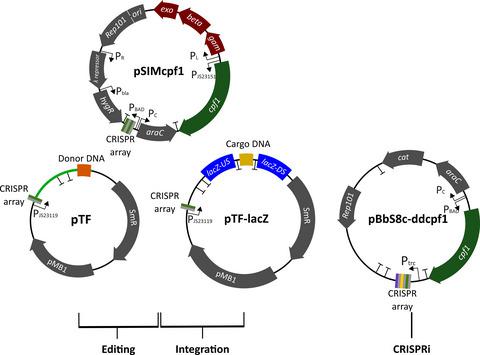当前位置:
X-MOL 学术
›
Microb. Biotechnol.
›
论文详情
Our official English website, www.x-mol.net, welcomes your
feedback! (Note: you will need to create a separate account there.)
A plasmid toolset for CRISPR‐mediated genome editing and CRISPRi gene regulation in Escherichia coli
Microbial Biotechnology ( IF 4.8 ) Pub Date : 2021-03-12 , DOI: 10.1111/1751-7915.13780 Adrian J Jervis 1 , Erik K R Hanko 1 , Mark S Dunstan 1 , Christopher J Robinson 1 , Eriko Takano 1 , Nigel S Scrutton 1
Microbial Biotechnology ( IF 4.8 ) Pub Date : 2021-03-12 , DOI: 10.1111/1751-7915.13780 Adrian J Jervis 1 , Erik K R Hanko 1 , Mark S Dunstan 1 , Christopher J Robinson 1 , Eriko Takano 1 , Nigel S Scrutton 1
Affiliation

|
CRISPR technologies have become standard laboratory tools for genetic manipulations across all kingdoms of life. Despite their origins in bacteria, the development of CRISPR tools for engineering bacteria has been slower than for eukaryotes; nevertheless, their function and application for genome engineering and gene regulation via CRISPR interference (CRISPRi) has been demonstrated in various bacteria, and adoption has become more widespread. Here, we provide simple plasmid‐based systems for genome editing (gene knockouts/knock‐ins, and genome integration of large DNA fragments) and CRISPRi in E. coli using a CRISPR‐Cas12a system. The described genome engineering protocols allow markerless deletion or genome integration in just seven working days with high efficiency (> 80% and 50%, respectively), and the CRISPRi protocols allow robust transcriptional repression of target genes (> 90%) with a single cloning step. The presented minimized plasmids and their associated design and experimental protocols provide efficient and effective CRISPR‐Cas12 genome editing, genome integration and CRISPRi implementation. These simple‐to‐use systems and protocols will allow the easy adoption of CRISPR technology by any laboratory.
中文翻译:

用于大肠杆菌中 CRISPR 介导的基因组编辑和 CRISPRi 基因调控的质粒工具集
CRISPR 技术已成为所有生命领域基因操作的标准实验室工具。尽管起源于细菌,但用于改造细菌的 CRISPR 工具的开发速度却慢于真核生物。尽管如此,它们通过 CRISPR 干扰 (CRISPRi) 进行基因组工程和基因调控的功能和应用已在多种细菌中得到证实,并且采用已变得更加广泛。在这里,我们提供简单的基于质粒的系统,用于基因组编辑(基因敲除/敲入以及大 DNA 片段的基因组整合)和使用 CRISPR-Cas12a 系统在大肠杆菌中进行 CRISPRi。所描述的基因组工程方案允许在短短七个工作日内以高效率进行无标记删除或基因组整合(分别为> 80%和50%),并且CRISPRi方案允许对目标基因进行强有力的转录抑制(> 90%)单个克隆步骤。所提出的最小化质粒及其相关设计和实验方案提供了高效且有效的 CRISPR-Cas12 基因组编辑、基因组整合和 CRISPRi 实施。这些简单易用的系统和协议将使任何实验室都能轻松采用 CRISPR 技术。
更新日期:2021-04-30
中文翻译:

用于大肠杆菌中 CRISPR 介导的基因组编辑和 CRISPRi 基因调控的质粒工具集
CRISPR 技术已成为所有生命领域基因操作的标准实验室工具。尽管起源于细菌,但用于改造细菌的 CRISPR 工具的开发速度却慢于真核生物。尽管如此,它们通过 CRISPR 干扰 (CRISPRi) 进行基因组工程和基因调控的功能和应用已在多种细菌中得到证实,并且采用已变得更加广泛。在这里,我们提供简单的基于质粒的系统,用于基因组编辑(基因敲除/敲入以及大 DNA 片段的基因组整合)和使用 CRISPR-Cas12a 系统在大肠杆菌中进行 CRISPRi。所描述的基因组工程方案允许在短短七个工作日内以高效率进行无标记删除或基因组整合(分别为> 80%和50%),并且CRISPRi方案允许对目标基因进行强有力的转录抑制(> 90%)单个克隆步骤。所提出的最小化质粒及其相关设计和实验方案提供了高效且有效的 CRISPR-Cas12 基因组编辑、基因组整合和 CRISPRi 实施。这些简单易用的系统和协议将使任何实验室都能轻松采用 CRISPR 技术。


















































 京公网安备 11010802027423号
京公网安备 11010802027423号